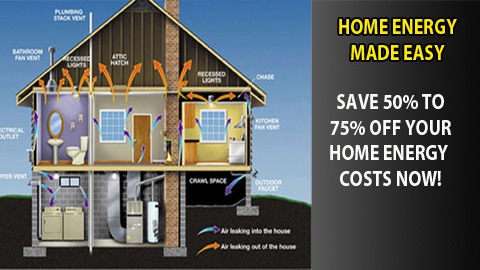The most important thing you need to take away from this lesson is…
Heating accounts for over one-third of your energy consumption. Solar heating can be as simple, or as complex, as you want it to be. But getting a simple passive solar heating system, enough to heat one or more rooms, can be done in an afternoon.

First, we need understand the basics, and the difference between active solar and passive solar heating systems. Although both of these are considered passive solar heating systems, since many people refer to solar panels as "active" as well.
Active Solar Heating
There are two basic types of active solar heating systems based on the type of fluid—either liquid or air—that is heated in the solar energy collectors. (The collector is the device in which a fluid is heated by the sun.) Liquid-based systems heat water or an antifreeze solution in a "hydronic" collector, whereas air-based systems heat air in an "air collector."
Economics and Other Benefits of Active Solar Heating Systems
Active solar heating systems are most cost-effective when they are used for most of the year, that is, in cold climates with good solar resources. They are most economical if they are displacing more expensive heating fuels, such as electricity, propane, and oil heat.
The cost of an active solar heating system will vary. Commercial systems range from $30 to $80 per square foot of collector area, installed.
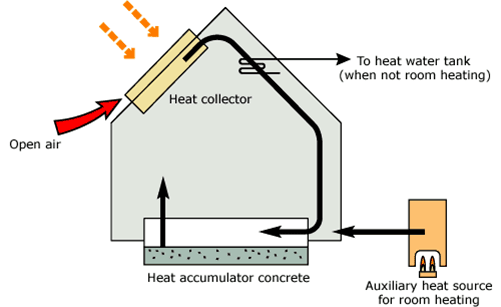
Heating your home with an active solar energy system can significantly reduce your fuel bills in the winter. A solar heating system will also reduce the amount of air pollution and greenhouse gases that result from your use of fossil fuels such as oil, propane, and natural gas for heating or that may be used to generate the electricity that you use.
Ventilation Preheating
Solar air heating systems use air as the working fluid for absorbing and transferring solar energy. Solar air collectors (devices to heat air using solar energy) can directly heat individual rooms or can potentially pre-heat the air passing into a heat recovery ventilator or through the air coil of an air-source heat pump.
Air collectors produce heat earlier and later in the day than liquid systems, so they may produce more usable energy over a heating season than a liquid system of the same size.
Also, unlike liquid systems, air systems do not freeze, and minor leaks in the collector or distribution ducts will not cause significant problems, although they will degrade performance. However, air is a less efficient heat transfer medium than liquid, so solar air collectors operate at lower efficiencies than solar liquid collectors.
Room Air Heaters
Air collectors can be installed on a roof or an exterior (south facing) wall for heating one or more rooms. Although factory-built collectors for on-site installation are available, do-it-yourselfers may choose to build and install their own air collector. A simple window air heater collector can be made for a few hundred dollars.
The collector has an airtight and insulated metal frame and a black metal plate for absorbing heat with glazing in front of it. Solar radiation heats the plate that, in turn, heats the air in the collector. An electrically powered fan or blower pulls air from the room through the collector, and blows it back into the room. Roof-mounted collectors require ducts to carry air between the room and the collector. Wall-mounted collectors are placed directly on a south-facing wall, and holes are cut through the wall for the collector air inlet and outlets.
Simple "window box collectors" fit in an existing window opening. They can be active (using a fan) or passive. In passive types, air enters the bottom of the collector, rises as it is heated, and enters the room.
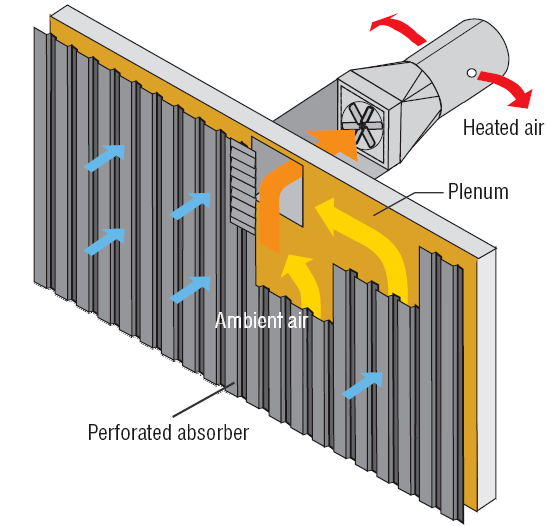
Transpired Air Collectors
Transpired air collectors use a simple passive solar heating technology to capture the sun's heat to warm buildings: The collectors consist of dark, perforated metal plates installed over a building's south-facing wall. An air space is created between the old wall and the new facade. The dark outer facade absorbs solar energy and rapidly heats up on sunny days—even when the outside air is cold.
A fan or blower draws ventilation air into the building through tiny holes in the collectors and up through the air space between the collectors and the south wall. The solar energy absorbed by the collectors warms the air flowing through them by as much as 40°F. Unlike other space heating technologies, transpired air collectors require no expensive glazing.
What You Can Do Starting Today
Passive Solar Heating
Once again, this is very simple. So simple it is easy to underestimate the amount of passive solar heat you can get from such devices. Use care and caution. You are literally “playing with fire.”
Here is a simple convection solar window heater, published in “Sunshine for Dollars”, by Steven Harris, you can make for .25 cents.
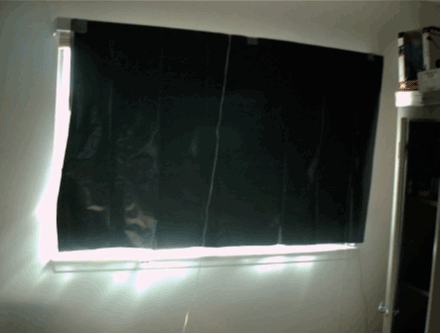
For optimum heat, you need:
• South or west facing windows, but any window where to sun is shining through will do.
• 3 mil. Black plastic
• A curtain rod over the window.
What you’re going to do:
- Simply hang the black plastic over the curtain rod so that it covers the full length of the window.
- That really is about all there is to it.
Here’s what’s going to happen:
- The suns heat will enter the window, heating up the back plastic. The colder air of the room, will enter through the bottom of the plastic.
- The hotter air, will exit back into the room through the top.
This passive solar heater is simple, easy, and economical. And it works. It works better than you think,
Why is this different?
When sunshine normally falls into a room, it will hit the carpet, a desk, a paper, a wall, or a sleeping dog. All of these items reflect, absorb, and bounce the light in a different fashion. Some light gets bounced onto the ceiling where part of the energy gets absorbed and reradiated as heat, while some of it gets reflected to other parts of the room.
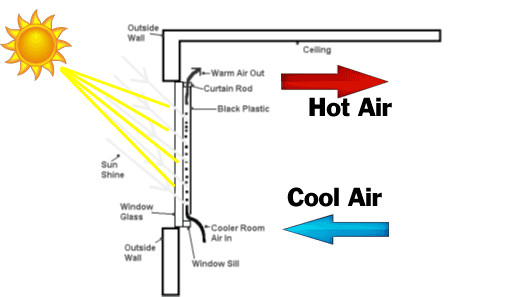
The black plastic sheet is VERY receptive in the absorption of sunlight, and absorbs most of the sunlight in one limited spot of air between the plastic and the glass. This reduces how fast the heat can get away and allows the air to get hotter (have a higher quality).
The black plastic absorbs the ultraviolet (visible and infrared wavelengths of sunlight) that make it through the glass, and re-radiates the energy as long wavelength infrared light. You can mildly feel this on your face when standing close to the plastic.
Cool air thermally siphons from the bottom of the plastic, warms up, and moves out the top of the plastic/window air gap. This simple passive solar heating trick noticeably warms the room up, making it feel much more pleasant. The whole window can be blocked with plastic, or only part of it can be blocked to save some of the view. I used a three Mil, black piece of plastic I got from Home Depot, but a black trash bag will work almost as well.
Now then, let’s step it up a notch…
I added a reflector outside the window to bounce more sunshine into the window. This actually puts “TWO Suns” onto the window, the sun that normally falls through the window and the reflected sunlight. This is called TWO SUNS. If I had a second reflector, this would be a total of “Three Suns” (DO NOT DO THIS).
Before the sunshine hid behind the clouds last four days here in Iowa, this reflector quickly got my air out temperatures above 85°F, and the sunshine was a little hazy.
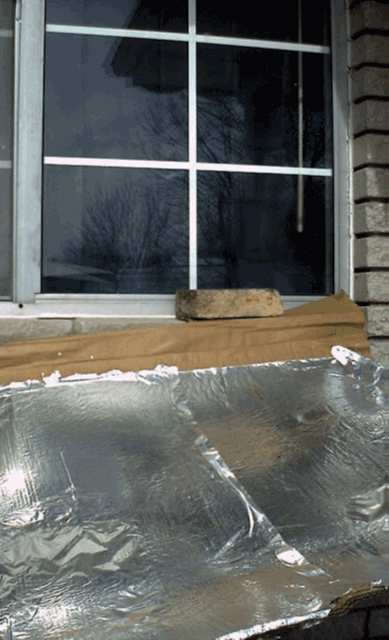
With my solar experience, I think this would of easily gotten over 100°F with a February sunshine in Iowa.
The reflector is aluminum foil with Elmer's glue on cardboard. I am going to re-do this with flat masonite. Adding a hinge or two allows for easier adjustments (rather than using the displayed brick method.)
DO NOT add more than ONE reflector to your unit. When it gets warmer and the sun gets stronger, multiple reflectors *WILL* actually get the plastic so hot that it WILL literally go POOF and up in flames. ONE reflector with REGULAR aluminum foil is more than enough. It is true that in areas like Michigan, we have a limited number of sunny days in December.
However, we have more sunny days in January, February and March, but it can EASILY be well below freezing during these months. Even during April and May, it can be in the forties, fifty’s and sixties. I LIKE my house 70°F+, and on these days during half the year, this little solar air heater will add gentle warmth that my furnace or wood stove does not have to add. It does it all by itself. I don’t have to turn it on.
This passive solar heating project can be done in ten minutes, and I can take it down and put it up in seconds. This project can also be done by anyone in an apartment.
Downloads/Resources (Click to view or right click to download)
Checklists, Cheat sheets,...

